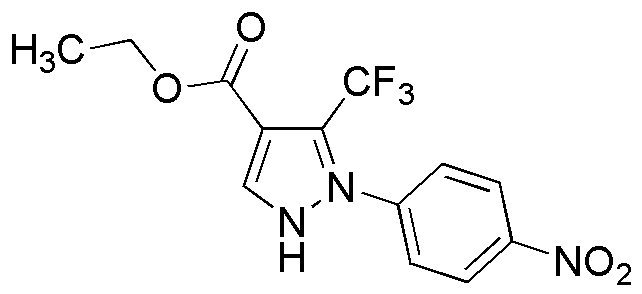Ethyl 2-(4-nitrophenyl)-3-(trifluoromethyl)pyrazole-4-carboxylate is widely utilized in research focused on:
- Agricultural Chemistry: This compound serves as a key intermediate in the synthesis of agrochemicals, particularly herbicides and fungicides, enhancing crop protection and yield.
- Pharmaceutical Development: It is studied for its potential as a pharmaceutical agent, particularly in developing drugs targeting inflammation and pain management, offering a new avenue for treatment options.
- Material Science: The compound is explored for its properties in creating advanced materials, such as polymers and coatings, which can provide improved durability and resistance to environmental factors.
- Analytical Chemistry: It is used in the development of analytical methods for detecting and quantifying nitro compounds in various samples, aiding in environmental monitoring and compliance.
- Research on Fluorinated Compounds: The unique trifluoromethyl group makes it valuable in studying the effects of fluorination on biological activity, contributing to the design of more effective compounds in medicinal chemistry.
General Information
Properties
Safety and Regulations
Applications
Ethyl 2-(4-nitrophenyl)-3-(trifluoromethyl)pyrazole-4-carboxylate is widely utilized in research focused on:
- Agricultural Chemistry: This compound serves as a key intermediate in the synthesis of agrochemicals, particularly herbicides and fungicides, enhancing crop protection and yield.
- Pharmaceutical Development: It is studied for its potential as a pharmaceutical agent, particularly in developing drugs targeting inflammation and pain management, offering a new avenue for treatment options.
- Material Science: The compound is explored for its properties in creating advanced materials, such as polymers and coatings, which can provide improved durability and resistance to environmental factors.
- Analytical Chemistry: It is used in the development of analytical methods for detecting and quantifying nitro compounds in various samples, aiding in environmental monitoring and compliance.
- Research on Fluorinated Compounds: The unique trifluoromethyl group makes it valuable in studying the effects of fluorination on biological activity, contributing to the design of more effective compounds in medicinal chemistry.
Documents
Safety Data Sheets (SDS)
The SDS provides comprehensive safety information on handling, storage, and disposal of the product.
Product Specification (PS)
The PS provides a comprehensive breakdown of the product’s properties, including chemical composition, physical state, purity, and storage requirements. It also details acceptable quality ranges and the product's intended applications.
Certificates of Analysis (COA)
Search for Certificates of Analysis (COA) by entering the products Lot Number. Lot and Batch Numbers can be found on a product’s label following the words ‘Lot’ or ‘Batch’.
*Catalog Number
*Lot Number
Certificates Of Origin (COO)
This COO confirms the country where the product was manufactured, and also details the materials and components used in it and whether it is derived from natural, synthetic, or other specific sources. This certificate may be required for customs, trade, and regulatory compliance.
*Catalog Number
*Lot Number
Safety Data Sheets (SDS)
The SDS provides comprehensive safety information on handling, storage, and disposal of the product.
DownloadProduct Specification (PS)
The PS provides a comprehensive breakdown of the product’s properties, including chemical composition, physical state, purity, and storage requirements. It also details acceptable quality ranges and the product's intended applications.
DownloadCertificates of Analysis (COA)
Search for Certificates of Analysis (COA) by entering the products Lot Number. Lot and Batch Numbers can be found on a product’s label following the words ‘Lot’ or ‘Batch’.
*Catalog Number
*Lot Number
Certificates Of Origin (COO)
This COO confirms the country where the product was manufactured, and also details the materials and components used in it and whether it is derived from natural, synthetic, or other specific sources. This certificate may be required for customs, trade, and regulatory compliance.


